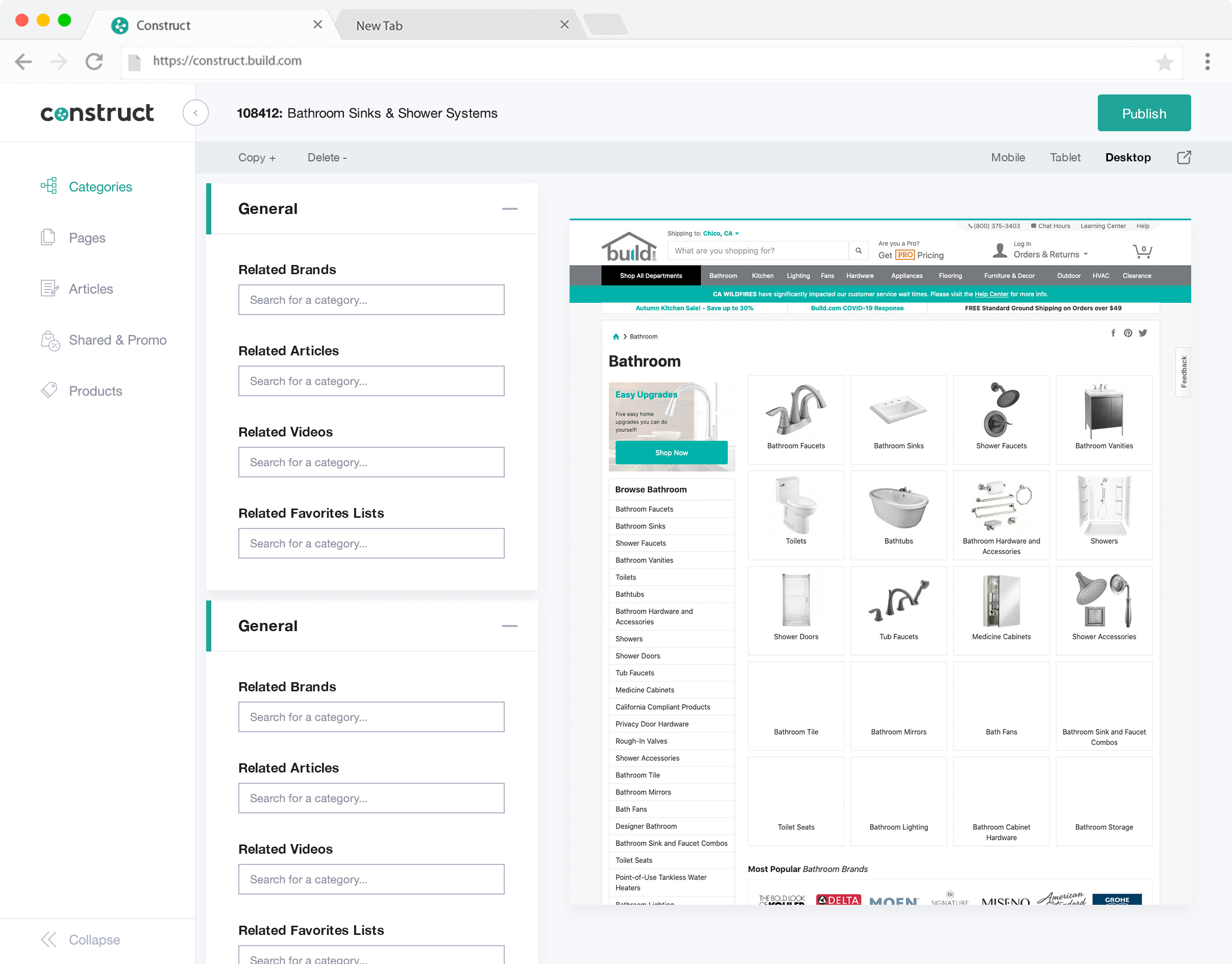Background
Build.com is an online home improvement retailer and subsidiary of Ferguson plc. It sells bathroom, kitchen and lighting hardware, appliances and other supplies to both home improvement professionals and consumers. As the senior UX designer, Build.com asked me help redesign a deeply broken content creation/publishing system which the business saw as an impediment to its growth.
Design Challenge
Chief among the goals for Build.com was to streamline how content was created and published by the internal merchandising teams to their network of websites. This would require a deep understanding of—and a subsequent rethinking of—the entire content creation process including planning, production, and publication. The process was previously time consuming and manual and was often so difficult to do that the merchandising teams would regularly crash the sites.
Outcomes
Our work led to the creation of Construct, a suite of headless merchandising digital products. Construct enabled Build.com to launch their first native app and allowed the merchandising teams to recapture 15 FTE’s in workflow efficiencies.
Impact
An empowered and optimized merchandising team scaled Build.com past $1B in annual revenue.
The Work

My Role
- Product Designer
- Product Manager
Team
- Jason Conkey - Full-stack Developer
- Robert Rees - Front-End Developer
- Ryan McCauley - Development lead
- Chrystal Jaeger - UX Researcher
- Ryan Sanders - Product Designer / Product Manager
- Robbie Reaves - Project Manager
- Kent O'Shea - QA Engineer
Dive Deeper
Build.com needed to pivot, quickly. After sixteen years of prioritizing speed over scalability, the scrappy startup had painted itself into a corner.
The merchandising organization had outgrown its manual publishing workflows and needed an overhaul. Merchandising Build.com’s network of sites was so manual in fact, that it was done exclusively via hand-written markup and SQL write statements. It was fragile and often, it was broken.
So Build.com asked me and a senior developer to redesign the way merchandisers create and publish content across the network of ecommerce sites. I worked with the major stakeholders—department heads, employees, developers, marketers and customers—to gather insights into what users needed.
The objective was to design something that would simplify how merchandisers create and publish content, to make it easier for departments to collaborate on promotions, and to enable the current team to merchandise new, non-HTML based properties such as the Build.com native apps without increasing headcount.
Rather than lean into the trend of WYSiWYG editors available in web publishing platforms of the time, the design solution was rooted in extreme deliverability and content templates to give the team just enough options to create compelling content at speed that could travel anywhere. Creating a promotional banner, for example, used to involve Photoshop, HTML, and staying up till midnight to manually place the banner on the page. The design solution instead allowed a merchandiser to fill out fields, choose banners styles, and schedule publishing across any number of sales channels without needing design or development expertise. This would later be termed “headless architecture” and an entire industry would spring up around it.
In the process of creating Construct, our headless content management system, we also discovered that we could help the native team hit their launch goals too. As launch neared, the team realized that all merchandising content was written in HTML and was unusable by the native app. Instead of pushing back deadlines, our team partnered with merchandisers to model, deploy, and populate over 1000 content records to make sure that the Build.com native app had category and article content on day one.
In the first three years, Construct users created over 18,000 content records and published them across 30 front-end experiences spanning from web-based ecommerce sites to native AR room builders. We tracked over 4,000 monthly user actions and iterated over 30 times on the product based on user testing and feedback. Our product created such value and speed-to-market for Build.com that Ferguson - Build's parent company - asked us to scale our offering into the larger enterprise so that all of it's business units could achieve the same velocity Build.com had. The product continues to be developed even today and is a key component in Ferguson’s enterprise ecommerce platform.